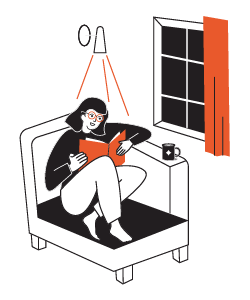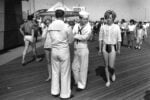Thomas Ruff – j_m_s_s_z
.jpg)
Legato da molto tempo alla galleria di Lia Rumma, che già nel 1991 presentava nel suo spazio napoletano i silenziosi ritratti di grandi dimensioni e le sue costellazioni, l’artista tedesco ha riunito per questa mostra un nutrito numero di lavori tratti dalle serie jpegs, ma.r.s., sterne, substrat, zycles (j_m_s_s_z), che testimoniano la varietà e l’ampiezza di una ricerca intrapresa alla fine degli anni Settanta alla Kunstakademie di Düsseldorf sotto la guida di Bernd e Hilla Becher.
Comunicato stampa
Legato da molto tempo alla galleria di Lia Rumma, che già nel 1991 presentava nel suo spazio napoletano i silenziosi ritratti di grandi dimensioni e le sue costellazioni, l’artista tedesco ha riunito per questa mostra un nutrito numero di lavori tratti dalle serie jpegs, ma.r.s., sterne, substrat, zycles (j_m_s_s_z), che testimoniano la varietà e l’ampiezza di una ricerca intrapresa alla fine degli anni Settanta alla Kunstakademie di Düsseldorf sotto la guida di Bernd e Hilla Becher.
Se agli artisti della cosiddetta Scuola di Düsseldorf la critica ha attribuito concordemente un ruolo fondamentale nell’affermazione, ormai inequivocabile, della fotografia come medium artistico, a Thomas Ruff in particolare è stata riconosciuta una costante quanto rigeneratrice intenzionalità di sperimentazione. A partire dai portraits realizzati negli anni Ottanta fino alle serie più recenti, Ruff ha trasformato la fotografia (e poi l’immagine digitale) in un campo di sperimentazione tecnica e in un luogo di indagine rigorosa sulla natura del mezzo e sui meccanismi che governano la costruzione dell’immagine. La molteplicità di tematiche affrontate, che segna l’avvicendarsi delle diverse serie, ha assecondato coerentemente tali istanze, consentendo di fatto di rispettare sia la profonda volontà analitica dell’artista che la sua spinta creativa – ogni ciclo di lavori rivela stupefacenti e inedite soluzioni visive – e spostando ogni volta più lontano i confini disciplinari, peraltro mai negati.
La mostra da Lia Rumma si articola intorno a questa significativa varietà di esiti e soluzioni, enfatizzandola sapientemente.
Ad accogliere il visitatore nella grande sala a piano terra, un mix di lavori: le fotografie della serie sterne (1989-1992) create a partire dagli scatti dell’emisfero australe realizzati con potenti telescopi dall’ESO (European Southern Observatory) che l’artista ha manipolato e ingrandito; i substrat del 2007, nei quali Ruff ha rielaborato immagini tratte da Manga e Anime giapponesi sottoponendole ad una progressiva sovrapposizione fino a farle diventare suadenti superfici astratte e tre zycles, ovvero stampe a getto d’inchiostro su tela riproducenti curve matematiche generate da programmi di modellazione tridimensionale.
L’interesse per l’astronomia, più volte manifestato dall’artista, è alla base anche dei lavori esposti al primo piano che appartengono alla recente serie ma.r.s. Per essi Ruff ha utilizzato immagini digitali del pianeta Marte scaricate dalle pagine web della NASA, trattate ingrandendo particolari e modificando il colore con violente saturazioni.
Concludono il percorso espositivo, al secondo piano, i lavori appartenenti alla serie jpeg, realizzati dal 2004, che per molti aspetti si offrono come una efficace sintesi della sua opera. Si tratta di fotografie scelte e non realizzate direttamente dall’artista, “dilatate in proporzioni imponenti, molto oltre i limiti concessi dalla propria definizione, le immagini prendono il tipico aspetto reticolato che rivela la griglia di compressione digitale sottostante; parlano insomma più della tecnologia di rappresentazione che del soggetto rappresentato” (Simone Menegoi, Thomas Ruff, MOUSSE MAGAZINE - Issue#1) .
Thomas Ruff (Zell am Harmersbach, Germania, 1958) studia fotografia dal 1977 al 1985 alla Staatlichen Kunstakademie di Düsseldorf, dove attualmente vive e lavora.
Mostre personali dedicate all’artista sono state realizzate, tra gli altri, dallo Stedelijk Museum, Amsterdam; Museum Folkwang, Essen; Museet for Samtidskunst, Oslo 2002; Tate Liverpool, 2003; Fondazione Bevilacqua La Masa 2006; Sprengel Museum, Hannover 2007; Moderna Museet, Stoccolma 2007; Kunsthalle Wien, Vienna 2009; Castello di Rivoli, Torino 2009; Centro de Arte Contemporáneo de Málaga, Malaga 2011; Haus der Kunst, Monaco 2012. Le sue opere sono ospitate nelle collezioni di numerose istituzioni museali: Hamburger Bahnhof, Berlino; The Art Institute of Chicago; Dallas Museum of Art; Hirshhorn Museum and Sculpture Garden, Washington, D.C.; The Metropolitan Museum of Art, New York; Moderna Museet, Stoccolma; National Gallery of Victoria, Melbourne; Solomon R. Guggenheim Museum, New York. In Italia le opere di Thomas Ruff sono conservate presso il MAXXI di Roma, il Castello di Rivoli e il MART di Rovereto.
Nel 2002, su invito di Lia Rumma, Ruff lavora alla serie m.d.p.n. dedicata al “tardo manifesto” dell’architettura razionalista a Napoli ovvero l’edificio del mercato ittico progettato da Luigi Cosenza tra il 1929 e il 1934, con cui l’artista ha dato seguito ai lavori dedicati all’architettura dopo le serie commissionata nel 1994 da Herzog & De Meuron e l.m.v.d.r., 1999-2001.
Nel 2006 riceve il premio Infinity Award dell’International Center of Photography di New York.
***
The German artist has long had ties with Galleria Lia Rumma, which back in 1991 showed his taciturn large-format portraits and his constellations in its Naples premises. For this exhibition, he has brought together a sizeable number of works from his jpegs, ma.r.s., sterne, substrat, zycles (j_m_s_s_z) series. Together they illustrate the variety and breadth of his artistic investigations, upon which he first embarked under Bernd and Hilla Becher in the late 1970s at the Kunstakademie in Düsseldorf. Critics have universally attributed the so-called School of Düsseldorf with playing a fundamental role in what became the definitive establishment of photography as an artistic medium, but it is Thomas Ruff in particular who has been seen as a constant, driving force behind this innovative direction and experimentation. From the portraits he made in the 1980s through to his most recent series, Ruff has transformed photography (and, more recently, digital images) into a field of technical experimentation and a place of meticulous investigation into the essence of the medium and into the mechanisms that govern the construction of the image. The diversity of themes he tackles in the various different series has been consistent with these aims, allowing him to respect both his deep desire for analysis and his creative drive. Each cycle of works reveals stunning, highly original visual solutions, each time shifting the boundaries of the discipline, while never denying their existence.
The exhibition at Lia Rumma's revolves around this great variety of outcomes and solutions, adeptly emphasising them.
Upon entering the large hall on the ground floor, the visitor is greeted by a mix of works: photographs from the sterne series (1989-1992) created from views of the southern hemisphere made by the powerful ESO (European Southern Observatory), which the artist has manipulated and enlarged; the substrat series of 2007, in which Ruff has reformulated images from Japanese manga and anime, subjecting them to gradual superimpositions until they turn into alluring abstract surfaces, and three zycles – inkjet prints on canvas that reproduce mathematical curves generated by 3-D modelling programs.
The artist's interest in astronomy, which he has often revealed, is also at the heart of the works shown on the first floor, which belong to his recent ma.r.s. series. In this case, Ruff has used digital images of the planet Mars downloaded from the NASA website, enlarging particular details and modifying the colours with intense saturations. The exhibition ends on the second floor with works from his jpeg series of 2004, which in many ways can be seen as an effective summary of all his work. These are photographs he has chosen but not taken himself, "dilated in prodigious proportions, well beyond the limits afforded by their own definition, the images acquire a typical reticular look that reveals the grid of digital compression beneath; in other words, they tell us more about the technology of reproduction than of the subjects portrayed" (Simone Menegoi, Thomas Ruff, MOUSSE MAGAZINE – Issue#1).
Thomas Ruff (Zell am Harmersbach,Germany,1958) studied photography from 1977 to 1985 at the Staatlichen Kunstakademie in Düsseldorf, where he currently lives and works. Solo exhibitions of his works have included those at the Stedelijk Museum, Amsterdam; Museum Folkwang, Essen; Museet for Samtidskunst, Oslo 2002; Tate Liverpool, 2003; Fondazione Bevilacqua La Masa 2006; Sprengel Museum, Hanover 2007; Moderna Museet, Stockholm 2007; Kunsthalle Wien, Vienna 2009; Castello di Rivoli, Turin 2009; Centro de Arte Contemporáneo de Málaga, Malaga 2011; Haus der Kunst, Munich 2012. His works are now in the permanent collections of many museums, including: Hamburger Bahnhof, Berlin; The Art Institute of Chicago; Dallas Museum of Art; Hirshhorn Museum and Sculpture Garden, Washington, D.C.; The Metropolitan Museum of Art, New York; Moderna Museet, Stockholm; National Gallery of Victoria, Melbourne; Solomon R. Guggenheim Museum, New York. In Italy, his works are in the collections of MAXXI in Rome, Castello di Rivoli and Mart in Rovereto.
In 2002, upon invitation by Lia Rumma, Ruff worked on the m.d.p.n. series devoted to the "late manifesto" of rationalist architecture in Naples – the fish-market building designed by Luigi Cosenza between 1929 and 1934 – with which Ruff continued his works on architecture after the series commissioned in 1994 by Herzog & De Meuron and l.m.v.d.r 1999-2001.
In 2006 he received the Infinity Award of the International Center of Photography in New York.



